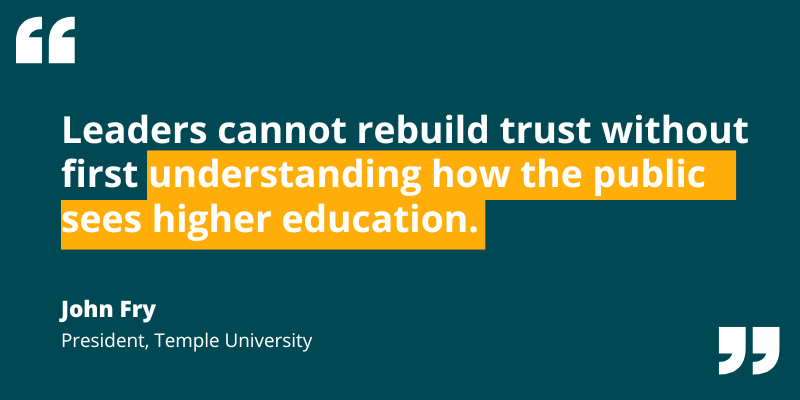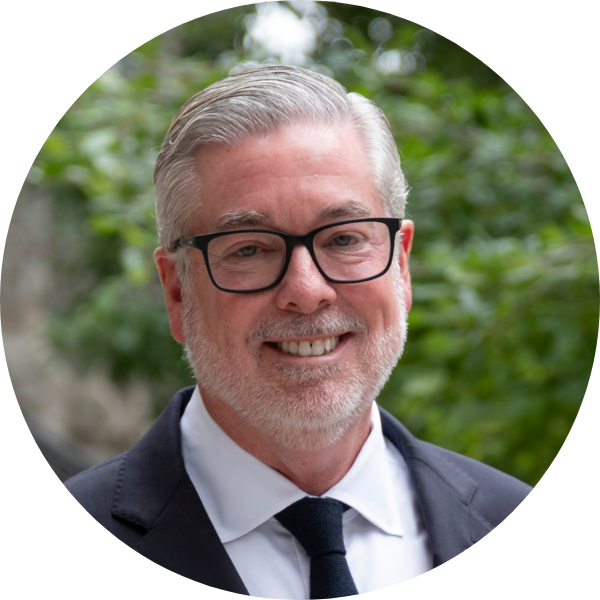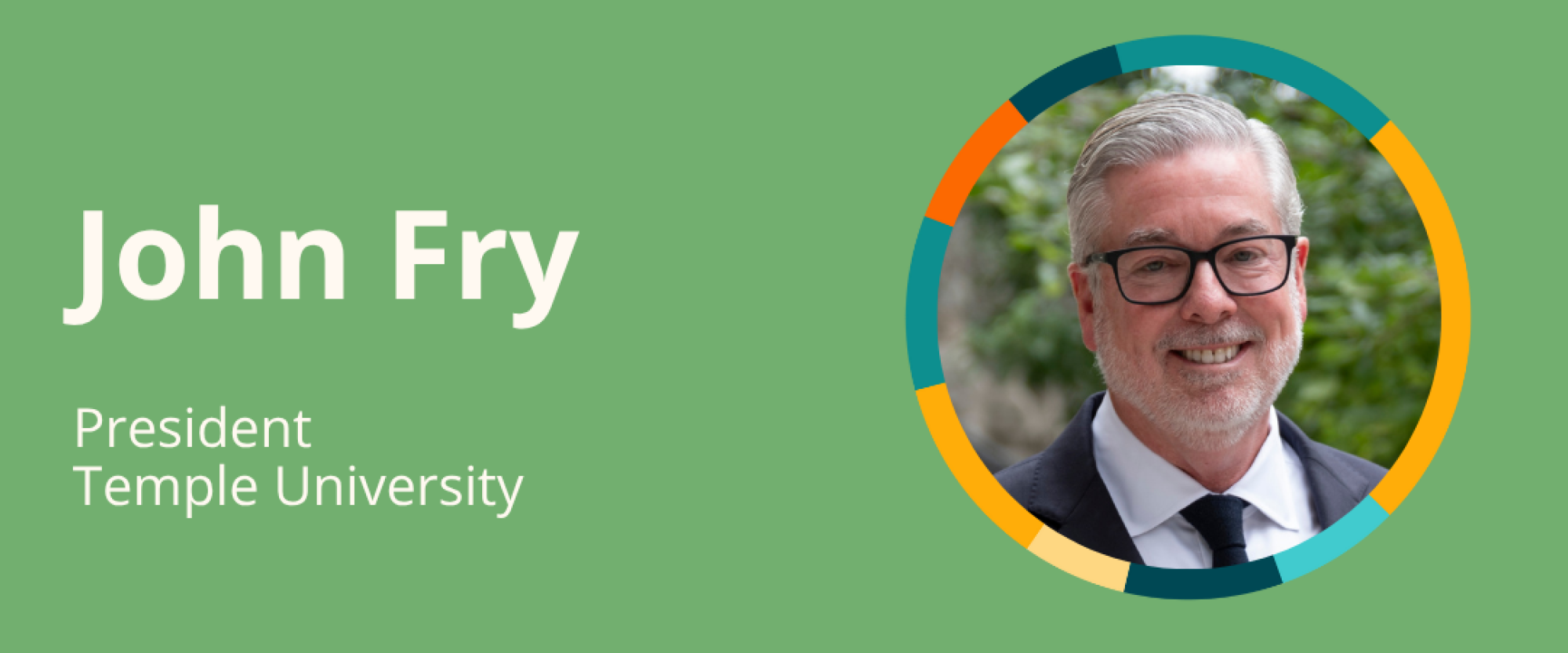President John Fry leads Temple University today, but his path to the presidency has been anything but traditional. Starting his career as a management consultant serving higher education, he entered campus leadership from the outside—a vantage point that continues to shape how he understands institutional change, public perception, and the realities facing modern university leaders.
Before stepping into his first campus role as chief operating officer at the University of Pennsylvania, Fry spent years advising universities on strategy and organizational reform. That shift—from giving recommendations to implementing them—gave him a rare perspective on how decisions are made, why change is difficult, and what higher education often overlooks about the expectations of the world beyond campus. His reflections in this conversation offer grounded lessons for leaders navigating today’s turbulent landscape: the cultural gaps presidents must manage, the demands of long-term leadership, and the importance of showing up as a civic partner in their regions.
Advising Other Leaders vs. Becoming a Leader
Fry’s transition from consultant to campus leader began with an abrupt shift: moving from offering advice to taking responsibility for implementing it.
“The worst thing that can ever happen to a consultant is when you're asked to implement your own recommendations,” recalls President Fry. “That's what they asked me to do with the University of Pennsylvania back in 1995. So, I went from being a partner at Coopers and Lybrand, where I ran their national higher education consulting practice, to becoming the Chief Operating Officer at Penn.”
When he stepped into that role, Fry immediately confronted the gap between recommending institutional change and carrying it out. The work required a different skill set, one shaped by campus culture, shared governance, and the pace at which universities move.
“I thought I was prepared, but it took me a while to get up the learning curve. I was making decisions quickly and forcing the pace, and I had to figure out how to do it in an institutional setting, in a way that was respectful and also kept the long game in mind. I really try to bring people along. We're in this together and we're going to build something enduring.”
Fry’s early adjustment period underscores one of the central realities of higher education leadership: the urgency leaders feel often collides with the slower, consensus-oriented processes that define academic institutions. Navigating that tension has shaped his leadership ever since.
What Higher Ed Leaders Miss About Public Perception

Higher education leaders operate in an immersive environment that centers students, faculty, and institutional priorities. However, that immersion can limit visibility into how people outside the academy, such as business leaders, policymakers, and community members, view universities.
President Fry argues that many outside higher education remain confused or frustrated by the way universities operate.
“They’re often perplexed about the operating model,” he explains, noting that shared governance, consensus-driven timelines, and academic rhythms differ sharply from business and government norms. “They feel these places don't necessarily operate as 12-month businesses. I think the culture is considered a little bit precious, and people resent the price of a college education and wonder how you could possibly get real value out of that.”
Fry’s observations reflect a widening disconnect: higher education sees itself through a mission-driven lens, while many outside the academy judge it by efficiency, transparency, affordability, and relevance. As political scrutiny intensifies, that gap becomes even more consequential.
“There’s a frustration,” he notes, “and it’s always been that way, which is worth remembering given the politics of our country right now.”
For Fry, leaders cannot repair public trust without first understanding these perceptions. Recognizing how higher ed is viewed from the outside is foundational to leading effectively on the inside.
Civic Engagement as a Presidential Practice
To bridge that gap, Fry argues that higher ed leaders must spend meaningful time outside their institutions. His own civic work—including service on the Federal Reserve Bank of Philadelphia’s board and leadership roles with the Chamber of Commerce—gives him insight into expectations, critiques, and regional needs.
“I try to understand the perspective of people who are directors, trustees, donors, or civic leaders,” he explains. “The more time you spend absorbing what they're concerned about and what they like, the more you figure out how to translate all that into something that could be your institution's competitive advantage.”
He views civic engagement not as an extra responsibility, but as essential to the presidency. By sitting in rooms across the region and listening to community concerns firsthand, he returns to campus with sharper context and more grounded leadership instincts.
A Client-Centered Mindset for University Leadership
Public skepticism toward higher education is driven in part by how institutions appear in the public square. Too often, Fry says, universities surface only when requesting funding or announcing major research breakthroughs. What follows is a perception that institutions disengage once the moment has passed.
His early business career shaped an alternative approach.
“Spending most of my twenties running a business gave me two things that really helped me,” he says. “Number one was having a profit-and-loss statement looming over me. Number two was if our clients didn’t want to employ us anymore, we didn’t have a business. I learned from an early age that if I don’t have a satisfied client, I don’t have anything.’”
He brings that mindset to higher ed by viewing stakeholders—elected officials, donors, alumni, faculty, and deans—as clients he is responsible for serving.
“From that perspective, my clients are now the elected officials, the donors, and my alumni, faculty, and deans. My job is to make sure that they have what they need to bring forward the aspirations they have for their colleges.”
Whether speaking with employers or civic leaders, he applies the same philosophy: serve first, ask later.
“In my role at Temple, and previously at Drexel, I spent a lot of time asking employers how we were doing in supplying talent and producing research that moves their work forward. These are my clients, and I’m here to serve them. Occasionally I will need their help, but for every favor I ask, I’ll do five in return.”
For Fry, leadership is service—not in theory, but in daily practice.
His journey from consultant to university president reveals a leader shaped by service, long-term thinking, and a clear understanding of how institutions are viewed beyond campus borders. President Fry's perspective underscores a simple but essential idea: higher education strengthens its impact and its credibility when leaders stay connected to the communities they serve and remain grounded in the shared work of moving their institutions forward. His reflections offer a reminder that the most enduring leadership comes from listening, partnering, and showing up with purpose—day after day, year after year.
Note: This episode of the University Innovation Alliance’s Innovating Together Podcast originally aired on October 20, 2025. The podcast appears live on YouTube, Facebook, Twitter, and LinkedIn.
Resources Mentioned in This Episode
- Temple University
From its origins as a free night school for working adults in Philadelphia, Temple University has grown to provide transformative opportunities for a vibrant student body in an environment of innovative teaching, experiential learning, and creative research. - PwC Higher Education Practice
John Fry’s previous employer Coopers and Lybrand has since merged with Price Waterhouse to form PricewaterhouseCoopers (aka PwC). Its higher education practice addresses the opportunities and challenges faced by higher education institutions, assisting clients in identifying opportunities to increase accountability and transparency, and to better align their resources to their missions. - Is College Still Worth It? A Debate on the Future of Higher Education and Economic Mobility - UIA
Watch the archive
Bios of Guest and Co-Hosts

John Fry took office as Temple University’s 15th president on Nov. 1, 2024. Under his leadership, the university launched Temple Future Scholars, a college pipeline program supporting low-income, first-generation students; established a significant physical presence in the heart of Philadelphia; and joined the UIA. President Fry has maintained a strong presence in the community for years, continuing to serve on the boards of the Federal Reserve Bank of Philadelphia and the Chamber of Commerce. Prior to assuming his current role at Temple, he led Drexel University from 2010 to 2024, where he elevated the university’s global presence through academic and research partnerships, major NIH and NSF research programs, as well as hubs for innovation and collaboration. Under President Fry’s leadership, Drexel set a national example for successful public-private partnerships, became a force for economic development in the Greater Philadelphia region, and built significant partnerships to support local neighborhood public schools. Before joining Drexel, he served as president of Franklin & Marshall College from 2002 to 2010 and executive vice president of the University of Pennsylvania from 1995 to 2002. A native of Brooklyn, N.Y., Fry graduated from Lafayette College and earned an MBA degree from the New York University Stern School of Business. He and his wife Cara, an art historian, have three children.

Co-Host: Bridget Burns, Executive Director, University Innovation Alliance
As a trusted advisor to university presidents and policymakers, Dr. Bridget Burns is on a mission to transform the way institutions think about and act on behalf of low-income, first-generation, and students of color. She is the founding CEO of the University Innovation Alliance, a multi-campus laboratory for student success innovation that helps university leaders dramatically accelerate the implementation of scalable solutions to increase the number of college graduates.

Co-Host: Sara Custer, Editor-in-Chief, Inside Higher Ed
Sara Custer became Inside Higher Ed’s editor-in-chief in 2024 after serving four years at Times Higher Education. At THE, she worked across departments to launch and grow the Campus platform, and then lead its editorial team. Prior to that role, she served as digital editor, helping to launch THE’s newsletter strategy and overseeing daily, weekly, and monthly publications. Ms. Custer was previously editor and senior reporter at The PIE News, a website and magazine covering the international education industry. She grew up in Cushing, OK., and earned a B.A. in English literature from Loyola University Chicago and an M.A. in international journalism from City, University of London. As a journalist, she has covered global higher education for more than five years.
About Innovating Together
Innovating Together is an event series that happens live on YouTube, Facebook, Twitter, and LinkedIn. It also becomes a podcast episode. Every week, we join forces with Inside Higher Ed and talk with a higher education luminary about student success innovations or a sitting college president or chancellor about how they're specifically navigating the challenges of leadership. We hope these episodes will leave you with a sense of optimism and a bit of inspiration.
Rate, Review & Subscribe
Learn why hundreds of people have rated the Innovating Together podcast 5 stars. Please join others and rate and review this podcast. This helps us reach and inform more people -- like you -- who are committed to helping more students succeed.
Click here, scroll to the bottom, tap to rate with five stars, and select “Write a Review.” Then be sure to let us know what you loved most about the episode. Also, if you haven’t done so already, subscribe to the podcast. You'll never miss an episode.

